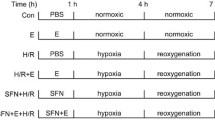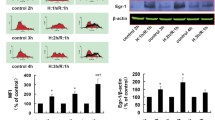Abstract
This study investigated the signal transduction pathway involved in the cytoprotective action of (−)schisandrin B [(−)Sch B, a stereoisomer of Sch B]. Using H9c2 cells, the authors examined the effects of (−)Sch B on MAPK and Nrf2 activation, as well as the subsequent eliciting of glutathione response and protection against apoptosis. Pharmacological tools, such as cytochrome P-450 (CYP) inhibitor, antioxidant, MAPK inhibitor, and Nrf2 RNAi, were used to delineate the signaling pathway. (−)Sch B caused a time-dependent activation of MAPK in H9c2 cells, with the degree of ERK activation being much larger than that of p38 or JNK. The MAPK activation was followed by an increase in the level of nuclear Nrf2, an indirect measure of Nrf2 activation, and the eliciting of a glutathione antioxidant response. The activation of MAPK and Nrf2 seemed to involve oxidants generated from a CYP-catalyzed reaction with (−)Sch B. Both ERK inhibition by U0126 and Nrf2 suppression by Nrf2 RNAi transfection largely abolished the cytoprotection against hypoxia/reoxygenation-induced apoptosis in (−)Sch B-pretreated cells. (−)Sch B pretreatment potentiated the reoxygenation-induced ERK activation, whereas both p38 and JNK activations were suppressed. Under the condition of ERK inhibition, Sch B treatment did not protect against ischemia/reperfusion injury in an ex vivo rat heart model. The results indicate that (−)Sch B triggers a redox-sensitive ERK/Nrf2 signaling, which then elicits a cellular glutathione antioxidant response and protects against hypoxia/reoxygenation-induced apoptosis in H9c2 cells. The ERK-mediated signaling is also likely involved in the cardioprotection afforded by Sch B in vivo.









Similar content being viewed by others
Abbreviations
- ABT:
-
1-Amino-benzotriazole
- AIF:
-
Apoptosis inducing factor
- CYP:
-
Cytochrome P-450
- DMTU:
-
Dimethylthiouracil
- DTT:
-
Dithiothreitol
- EpRE:
-
Electrophile response element
- ERK:
-
Extracellular signal-regulated protein kinase
- GCL:
-
γ-Glutamyl cysteine ligase
- G6PDH:
-
Glucose-6-phosphate dehydrogenase
- GR:
-
Glutathione reductase
- GSH:
-
Reduced glutathione
- JNK:
-
C-jun-NH2-terminal kinases
- LDH:
-
Lactate dehydrogenase
- MAPK:
-
Mitogen-activated protein kinases
- mGCL:
-
Modulatory subunit of GCL
- Nrf2:
-
Nuclear factor erythroid 2-related factor 2
- p38:
-
p38 MAPK
- PMSF:
-
Phenylmethylsulphonyl fluoride
- ROS:
-
Reactive oxygen species
- Sch B:
-
Schisandrin B
- SDS:
-
Sodium docecyl sulfate
- Trx:
-
Thioredoxin-1
References
Ko RKM, Mak DHF (2004) Schisandrin B and other dibenzocyclooctadiene lignans. In: Packer L, Halliwel B, Ong CN (eds) Herbal and traditional medicine: molecular aspects of health. Marcel Dekker, New York, pp 289–314
Yim TK, Ko KM (1999) Methylenedioxy group and cyclooctadiene ring as structural determinants of schisandrin in protecting against myocardial ischemia-reperfusion injury in rats. Biochem Pharmacol 57:77–81
Yim TK, Ko KM (1999) Schisandrin B protects against myocardial ischemia-reperfusion injury by enhancing myocardial glutathione antioxidant status. Mol Cell Biochem 196:151–156
Chiu PY, Ko KM (2003) Time-dependent enhancement in mitochondrial glutathione status and ATP generation capacity by schisandrin B treatment decreases the susceptibility of rat hearts to ischemia-reperfusion injury. Biofactors 19:43–51
Chiu PY, Leung HY, Siu AH, Poon MK, Ko KM (2007) Schisandrin B decreases the sensitivity of mitochondria to calcium ion-induced permeability transition and protects against ischemia-reperfusion injury in rat hearts. Acta Pharmacol Sin 28:1559–1565
Chiu PY, Leung HY, Poon MK, Mak DH, Ko KM (2006) (−)Schisandrin B is more potent than its enantiomer in enhancing cellular glutathione and heat shock protein production as well as protecting against oxidant injury in H9c2 cardiomyocytes. Mol Cell Biochem 289:185–191
Chiu PY, Luk KF, Leung HY, Ng KM, Ko KM (2008) Schisandrin B stereoisomers protect against hypoxia/reoxygenation-induced apoptosis and inhibit associated changes in Ca2+-induced mitochondrial permeability transition and mitochondrial membrane potential in H9c2 cardiomyocytes. Life Sci 82:1092–1101
Chiu PY, Ko KM (2004) Schisandrin B protects myocardial ischemia-reperfusion injury partly by inducing Hsp25 and Hsp70 expression in rats. Mol Cell Biochem 266:139–144
Baek MS, Kim JY, Myung SW, Yim YH, Jeong JH, Kim DH (2001) Metabolism of dimethyl-4,4′-dimethoxy-5,6,5′,6′-dimethylene dioxybiphenyl-2,2′-dicarboxylate (DDB) by human liver microsomes: characterization of metabolic pathways and of cytochrome P450 isoforms involved. Drug Metab Dispos 29:381–388
Chen N, Ko M (2010) Schisandrin B-induced glutathione antioxidant response and cardioprotection are mediated by reactive oxidant species production in rat hearts. Biol Pharm Bull 33:825–829
D’Autreaux B, Toledano MB (2007) ROS as signalling molecules: mechanisms that generate specificity in ROS homeostasis. Nat Rev Mol Cell Biol 8:813–824
Dalton TP, Shertzer HG, Puga A (1999) Regulation of gene expression by reactive oxygen. Annu Rev Pharmacol Toxicol 39:67–101
Lyakhovich VV, Vavilin VA, Zenkov NK, Menshchikova EB (2006) Active defense under oxidative stress. The antioxidant responsive element. Biochemistry (Mosc) 71:962–974
McCubrey JA, Lahair MM, Franklin RA (2006) Reactive oxygen species-induced activation of the MAP kinase signaling pathways. Antioxid Redox Signal 8:1775–1789
Torres M, Forman HJ (2003) Redox signaling and the MAP kinase pathways. Biofactors 17:287–296
Johnson GL, Lapadat R (2002) Mitogen-activated protein kinase pathways mediated by ERK, JNK, and p38 protein kinases. Science 298:1911–1912
Dougherty CJ, Kubasiak LA, Prentice H, Andreka P, Bishopric NH, Webster KA (2002) Activation of c-Jun N-terminal kinase promotes survival of cardiac myocytes after oxidative stress. Biochem J 362:561–571
Tanos T, Marinissen MJ, Leskow FC, Hochbaum D, Martinetto H, Gutkind JS, Coso OA (2005) Phosphorylation of c-Fos by members of the p38 MAPK family. Role in the AP-1 response to UV light. J Biol Chem 280:18842–18852
Viktorsson K, Ekedahl J, Lindebro MC, Lewensohn R, Zhivotovsky B, Linder S, Shoshan MC (2003) Defective stress kinase and Bak activation in response to ionizing radiation but not cisplatin in a non-small cell lung carcinoma cell line. Exp Cell Res 289:256–264
Zheng M, Reynolds C, Jo SH, Wersto R, Han Q, Xiao RP (2005) Intracellular acidosis-activated p38 MAPK signaling and its essential role in cardiomyocyte hypoxic injury. FASEB J 19:109–111
Crowe DL, Shemirani B (2000) The transcription factor ATF-2 inhibits extracellular signal regulated kinase expression and proliferation of human cancer cells. Anticancer Res 20:2945–2949
Echave P, Machado-da-Silva G, Arkell RS, Duchen MR, Jacobson J, Mitter R, Lloyd AC (2009) Extracellular growth factors and mitogens cooperate to drive mitochondrial biogenesis. J Cell Sci 122:4516–4525
Ouwens DM, de Ruiter ND, van der Zon GC, Carter AP, Schouten J, van der Burgt C, Kooistra K, Bos JL, Maassen JA, Van Dam H (2002) Growth factors can activate ATF2 via a two-step mechanism: phosphorylation of Thr71 through the Ras-MEK-ERK pathway and of Thr69 through RalGDS-Src-p38. EMBO J 21:3782–3793
Zhong CY, Zhou YM, Douglas GC, Witschi H, Pinkerton KE (2005) MAPK/AP-1 signal pathway in tobacco smoke-induced cell proliferation and squamous metaplasia in the lungs of rats. Carcinogenesis 26:2187–2195
Copple IM, Goldring CE, Kitteringham NR, Park BK (2008) The Nrf2-Keap1 defence pathway: role in protection against drug-induced toxicity. Toxicology 246:24–33
Eggler AL, Gay KA, Mesecar AD (2008) Molecular mechanisms of natural products in chemoprevention: induction of cytoprotective enzymes by Nrf2. Mol Nutr Food Res 52(Suppl 1):S84–S94
Owuor ED, Kong AN (2002) Antioxidants and oxidants regulated signal transduction pathways. Biochem Pharmacol 64:765–770
Jeyapaul J, Jaiswal AK (2000) Nrf2 and c-Jun regulation of antioxidant response element (ARE)-mediated expression and induction of gamma-glutamylcysteine synthetase heavy subunit gene. Biochem Pharmacol 59:1433–1439
Kensler TW, Wakabayashi N, Biswal S (2007) Cell survival responses to environmental stresses via the Keap1-Nrf2-ARE pathway. Annu Rev Pharmacol Toxicol 47:89–116
Liu XP, Goldring CE, Copple IM, Wang HY, Wei W, Kitteringham NR, Park BK (2007) Extract of Ginkgo biloba induces phase 2 genes through Keap1-Nrf2-ARE signaling pathway. Life Sci 80:1586–1591
Zhang Y, Munday R, Jobson HE, Munday CM, Lister C, Wilson P, Fahey JW, Mhawech-Fauceglia P (2006) Induction of GST and NQO1 in cultured bladder cells and in the urinary bladders of rats by an extract of broccoli (Brassica oleracea italica) sprouts. J Agric Food Chem 54:9370–9376
Ko KM, Mak DH, Li PC, Poon MK, Ip SP (1995) Enhancement of hepatic glutathione regeneration capacity by a lignan-enriched extract of Fructus schisandrae in rats. Jpn J Pharmacol 69:439–442
Luk KF, Ko KM, Ng KM (2008) Separation and purification of (−)schisandrin B from schisandrin B stereoisomers. Biochem Eng J 42:55–60
Cullinan SB, Zhang D, Hannink M, Arvisais E, Kaufman RJ, Diehl JA (2003) Nrf2 is a direct PERK substrate and effector of PERK-dependent cell survival. Mol Cell Biol 23:7198–7209
Griffith OW (1980) Determination of glutathione and glutathione disulfide using glutathione reductase and 2-vinylpyridine. Anal Biochem 106:207–212
Erfle H, Neumann B, Rogers P, Bulkescher J, Ellenberg J, Pepperkok R (2008) Work flow for multiplexing siRNA assays by solid-phase reverse transfection in multiwell plates. J Biomol Screen 13:575–580
Tobiume K, Matsuzawa A, Takahashi T, Nishitoh H, Morita K, Takeda K, Minowa O, Miyazono K, Noda T, Ichijo H (2001) ASK1 is required for sustained activations of JNK/p38 MAP kinases and apoptosis. EMBO Rep 2:222–228
Chang F, Steelman LS, Shelton JG, Lee JT, Navolanic PM, Blalock WL, Franklin R, McCubrey JA (2003) Regulation of cell cycle progression and apoptosis by the Ras/Raf/MEK/ERK pathway (review). Int J Oncol 22:469–480
Yuan X, Xu C, Pan Z, Keum YS, Kim JH, Shen G, Yu S, Oo KT, Ma J, Kong AN (2006) Butylated hydroxyanisole regulates ARE-mediated gene expression via Nrf2 coupled with ERK and JNK signaling pathway in HepG2 cells. Mol Carcinog 45:841–850
Wu CC, Hsu MC, Hsieh CW, Lin JB, Lai PH, Wung BS (2006) Upregulation of heme oxygenase-1 by epigallocatechin-3-gallate via the phosphatidylinositol 3-kinase/Akt and ERK pathways. Life Sci 78:2889–2897
Na HK, Kim EH, Jung JH, Lee HH, Hyun JW, Surh YJ (2008) (−)-Epigallocatechin gallate induces Nrf2-mediated antioxidant enzyme expression via activation of PI3K and ERK in human mammary epithelial cells. Arch Biochem Biophys 476:171–177
Zipper LM, Mulcahy RT (2003) Erk activation is required for Nrf2 nuclear localization during pyrrolidine dithiocarbamate induction of glutamate cysteine ligase modulatory gene expression in HepG2 cells. Toxicol Sci 73:124–134
Sun Z, Huang Z, Zhang DD (2009) Phosphorylation of Nrf2 at multiple sites by MAP kinases has a limited contribution in modulating the Nrf2-dependent antioxidant response. PLoS ONE 4:e6588
Jain M, Brenner DA, Cui L, Lim CC, Wang B, Pimentel DR, Koh S, Sawyer DB, Leopold JA, Handy DE, Loscalzo J, Apstein CS, Liao R (2003) Glucose-6-phosphate dehydrogenase modulates cytosolic redox status and contractile phenotype in adult cardiomyocytes. Circ Res 93:e9–e16
Han D, Hanawa N, Saberi B, Kaplowitz N (2006) Mechanisms of liver injury. III. Role of glutathione redox status in liver injury. Am J Physiol Gastrointest Liver Physiol 291:G1–G7
Franklin CC, Backos DS, Mohar I, White CC, Forman HJ, Kavanagh TJ (2009) Structure, function, and post-translational regulation of the catalytic and modifier subunits of glutamate cysteine ligase. Mol Asp Med 30:86–98
Circu ML, Aw TY (2010) Reactive oxygen species, cellular redox systems, and apoptosis. Free Radic Biol Med 48:749–762
Tao L, Gao E, Hu A, Coletti C, Wang Y, Christopher TA, Lopez BL, Koch W, Ma XL (2006) Thioredoxin reduces post-ischemic myocardial apoptosis by reducing oxidative/nitrative stress. Br J Pharmacol 149:311–318
Shioji K, Nakamura H, Masutani H, Yodoi J (2003) Redox regulation by thioredoxin in cardiovascular diseases. Antioxid Redox Signal 5:795–802
Das DK, Maulik N (2003) Preconditioning potentiates redox signaling and converts death signal into survival signal. Arch Biochem Biophys 420:305–311
Turoczi T, Chang VW, Engelman RM, Maulik N, Ho YS, Das DK (2003) Thioredoxin redox signaling in the ischemic heart: an insight with transgenic mice overexpressing Trx1. J Mol Cell Cardiol 35:695–704
Shioji K, Kishimoto C, Nakamura H, Masutani H, Yuan Z, Oka S, Yodoi J (2002) Overexpression of thioredoxin-1 in transgenic mice attenuates adriamycin-induced cardiotoxicity. Circulation 106:1403–1409
Das DK, Maulik N (2004) Conversion of death signal into survival signal by redox signaling. Biochemistry (Mosc) 69:10–17
Acknowledgments
This study was supported by a GRF Grant (Project number: 661107) (Principal Investigator Dr. K.M. Ko) from the Research Grants Council, Hong Kong.
Author information
Authors and Affiliations
Corresponding author
Rights and permissions
About this article
Cite this article
Chiu, P.Y., Chen, N., Leong, P.K. et al. Schisandrin B elicits a glutathione antioxidant response and protects against apoptosis via the redox-sensitive ERK/Nrf2 pathway in H9c2 cells. Mol Cell Biochem 350, 237–250 (2011). https://doi.org/10.1007/s11010-010-0703-3
Received:
Accepted:
Published:
Issue Date:
DOI: https://doi.org/10.1007/s11010-010-0703-3




